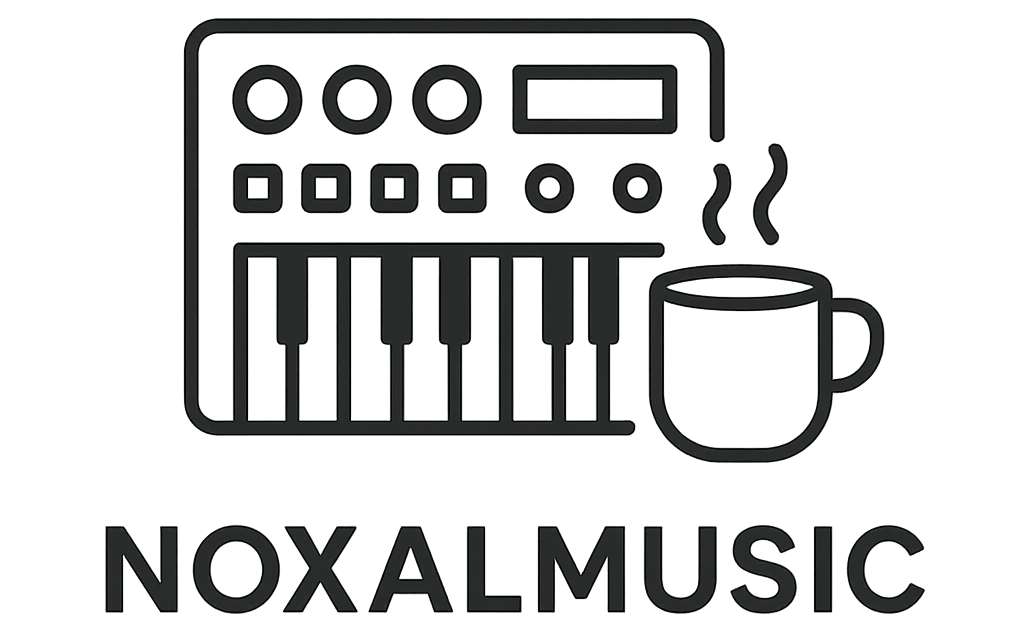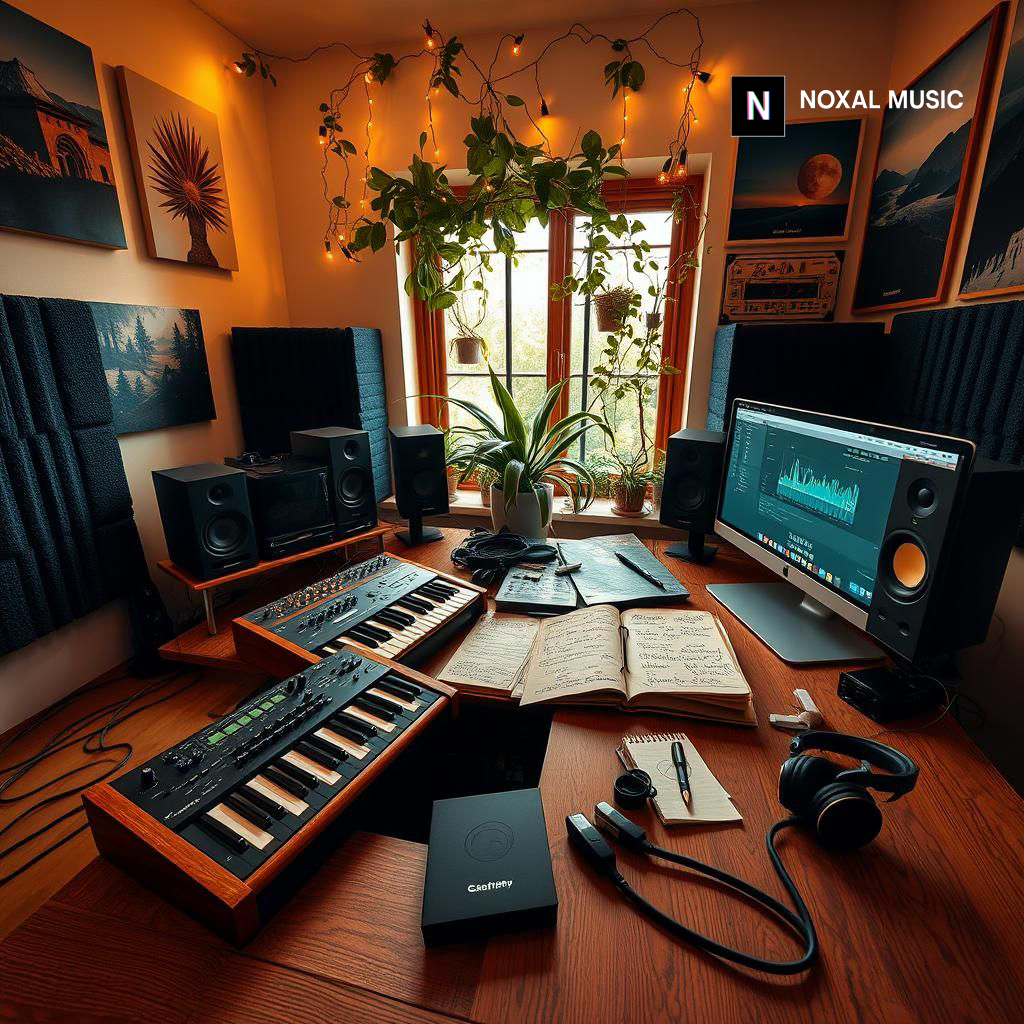Beyond the Presets: How the Synth Topic in Music Production Unlocks Unprecedented Creativity
Estimated reading time: 8 minutes
- Creativity Catalyst: Synthesizers are not just instruments; they redefine the way we create music.
- Sound Generation: Synths offer unparalleled freedom to sculpt and design unique sounds.
- Compositional Partners: Tools like arpeggiators and sequencers inspire new musical ideas.
- Impact on Storytelling: Synths are pivotal in creating atmospheric soundscapes, especially in film.
- Diversification: They have made sophisticated sound design accessible, democratizing music production.
Table of Contents
- The Genesis of Sound: Where Creativity Truly Begins
- Synths as Idea Generators: Beyond Traditional Composition
- The Cinematic Canvas: Blade Runner and the Art of Atmosphere
- Synths Across Genres: Democratizing and Diversifying Music
- Practical Takeaways for Your Studio Workflow
- The Noxal Perspective: Our Commitment to Sonic Innovation
- FAQ
The Genesis of Sound: Where Creativity Truly Begins
One of the most immediate ways the synth topic in music production fuels creativity is through its unparalleled ability to generate and sculpt sound. Unlike a guitar or piano, which come with their inherent timbres, a synthesizer is a blank slate. Its oscillators, filters, envelopes, and modulation sources offer an infinite palette, allowing you to craft entirely new sonic textures from scratch. This fundamental freedom is where the magic truly starts.
Think about it: an acoustic drum kit provides a finite set of sounds. A synth, however, can create kicks that hit with seismic force, snares that crackle with digital electricity, or hi-hats that shimmer with metallic resonance – sounds that exist only because you willed them into being. This bespoke sound design isn’t just about novelty; it’s about finding the exact sonic fingerprint your track needs to convey its message, evoke its mood, or define its genre.
I remember spending countless hours on my first serious analog synth, a Korg Minilogue, just twisting knobs, listening to how a slight adjustment of the filter cutoff or resonance could transform a simple saw wave into something entirely new – a growling bass, a shimmering pad, a percussive stab. It wasn’t about trying to replicate an existing sound; it was about the thrill of discovery, the “aha!” moment when an unexpected timbre sparked a new melodic idea or rhythmic pattern. This hands-on, exploratory approach is something we at Noxal champion: getting lost in the synthesis engine is often the fastest route to true originality.
Synths as Idea Generators: Beyond Traditional Composition
Synthesizers don’t just give you new sounds; they often give you new ideas. Their built-in sequencers, arpeggiators, and LFOs (Low-Frequency Oscillators) can become compositional partners, pushing you beyond conventional melodic or harmonic structures.
- Arpeggiators: A simple chord can be transformed into a dynamic, rhythmic sequence, instantly suggesting basslines, lead melodies, or textural accompaniment. I’ve often started a track just by feeding a few notes into an arpeggiator and letting it generate a hypnotic pattern, then building the rest of the song around that pulsating core. It’s an instant jolt of inspiration.
- Sequencers: Whether it’s a step sequencer on an analog drum machine or a sophisticated polyphonic sequencer on a modern digital workstation, these tools encourage a different way of thinking about melody and rhythm. Instead of playing notes in real-time, you’re programming them, often visually, which can lead to unexpected phrasing and complex, interlocking patterns that would be difficult to perform manually. This is particularly vital in electronic music production, where intricate rhythms and repetitive, evolving motifs are often key.
- Modulation: The ability to modulate almost any parameter with another (e.g., an LFO controlling filter cutoff, or an envelope influencing pitch) creates evolving soundscapes that feel alive and organic, even when they’re entirely electronic. This adds a layer of depth and movement that can prevent tracks from feeling static, keeping the listener engaged through subtle sonic shifts.
This interactive feedback loop between producer and instrument is crucial. You’re not just playing a synth; you’re collaborating with it. This dynamic interplay can break you out of creative ruts, offering fresh perspectives and forcing you to adapt your compositional approach to the unique characteristics of the synth itself. For anyone involved in music production, this kind of generative creativity is invaluable.
The Cinematic Canvas: Blade Runner and the Art of Atmosphere
To truly appreciate the transformative power of the synth topic in music production, we need to look at its impact on storytelling, particularly in film. No discussion of synthesizers in cinema would be complete without acknowledging Vangelis’s iconic score for Ridley Scott’s 1982 masterpiece, Blade Runner. This soundtrack is not just music; it’s an integral part of the film’s identity, a character unto itself, and a shining example of how synthesizers can create an entire world.
Vangelis, a pioneer in electronic music, leveraged the nascent power of synthesizers – primarily the Yamaha CS-80, along with the Sequential Circuits Prophet-5 and ARP Odyssey – to craft an atmosphere that was simultaneously melancholic, futuristic, and deeply human. He didn’t just write melodies; he painted sonic textures that evoked the film’s dystopian Los Angeles, its perpetually raining, neon-drenched streets, and the existential dread of its replicant inhabitants.
Consider the main theme, Blade Runner Blues, or the haunting beauty of Tears in Rain. These pieces aren’t driven by soaring orchestral arrangements; they are propelled by rich, evolving synth pads, ethereal arpeggios, and percussive metallic clangs that feel both organic and utterly alien. The characteristic warm, slightly detuned brass-like sounds of the CS-80 became synonymous with the film’s aesthetic, creating a feeling of profound isolation and contemplative beauty. It’s a masterclass in how sonic choices can deepen narrative and emotional impact.
When I first delved into the Blade Runner soundtrack, I wasn’t just hearing music; I was feeling the rain, seeing the towering advertisements, and sensing the weight of Deckard’s mission. Vangelis understood that synthesizers could go beyond merely accompanying a scene; they could define its very essence, filling the void with sounds that traditional instruments simply couldn’t produce. This isn’t just about “cool sounds”; it’s about crafting an immersive, unforgettable experience. This highlights the deep importance of synthesizers in music for setting a mood, evoking an emotion, and becoming an indelible part of our cultural fabric.
Synths Across Genres: Democratizing and Diversifying Music
The impact of synthesizers extends far beyond film scores. From the experimental electronic soundscapes of Kraftwerk and Tangerine Dream, which laid the groundwork for entire genres, to the infectious grooves of disco and house, synths have consistently pushed musical boundaries. In the realm of electronic music, artists like Aphex Twin have used synths to craft incredibly complex and innovative sound designs, shaping the very language of IDM. Meanwhile, Daft Punk’s fusion of funk, disco, and French house relies heavily on iconic synth sounds, proving their versatility and timeless appeal.
Even in genres not traditionally associated with electronic music, synthesizers have found their way, adding texture, depth, and sometimes an entirely new sonic dimension. Hip-hop producers often use synth samples or create custom synth basslines and pads to give their beats a distinctive edge. Indie rock bands integrate synths for atmospheric layers or catchy lead hooks. This widespread adoption underscores the idea that synthesizers are not niche instruments; they are universal tools for musical expression, empowering musicians and producers at all levels.
For us at Noxal, this democratizing aspect is particularly exciting. Synths, especially software synthesizers and more affordable hardware, have made sophisticated sound design accessible to a wider audience than ever before. This means more diverse voices, more experimental sounds, and ultimately, a richer and more varied musical landscape.
Practical Takeaways for Your Studio Workflow
So, how can you harness the creative power of the synth topic in music production in your own studio? Here are a few actionable tips:
- Embrace Exploration, Not Just Replication: Don’t always reach for presets. Spend dedicated time just creating sounds from initialization patches. Twist knobs, push buttons, listen actively. You’ll stumble upon sounds you never intended, and those “happy accidents” are often the most inspiring. This process is fundamental to developing your own unique sonic signature.
- Learn One Synth Deeply: Instead of buying every new synth plugin or piece of hardware, pick one – hardware or software – and truly master it. Understand its signal flow, its modulation capabilities, its strengths, and its limitations. When you know an instrument inside out, you can coax incredible sounds from it and apply that knowledge to others.
- Use Synths as Song Starters: If you’re stuck for an idea, try starting with a synth. Create an interesting pad, a compelling arpeggio, or a unique bass sound, and then build your track around that core. Sometimes, the sound itself will dictate the melody or harmony. I often find a complex, evolving pad can instantly set the mood for an entire composition.
- Layer and Process: Don’t be afraid to layer multiple synth sounds to create rich, complex textures. Also, experiment with external processing – reverb, delay, distortion, chorus, flanger – to further sculpt and enhance your synth patches. A simple sine wave can become a cosmic drone with the right effects chain.
- Context is Key: While sound design is fun, always consider how your synth sound fits within the overall mix. Does it serve the song? Is it occupying the right frequency space? A great sound in isolation isn’t necessarily a great sound in a full arrangement. Use your synths to complement other elements, creating a cohesive and compelling whole.
- Study the Masters: Listen to how your favorite artists use synthesizers. Deconstruct their tracks. Can you identify the types of synths they might be using? How do their synth sounds contribute to the emotional impact or groove of the song? This kind of active listening is a powerful learning tool.
The Noxal Perspective: Our Commitment to Sonic Innovation
At Noxal, we believe that understanding the synth topic in music production is crucial for any modern musician or producer. It’s not just about staying current with gear; it’s about embracing a mindset of limitless creativity and sonic discovery. We are passionate about delving into the intricacies of synthesis, sharing practical tips, and celebrating the artists who continue to push the boundaries of what’s possible with these incredible machines. Our editorial project aims to be a resource for both seasoned veterans and curious newcomers, a place where the love for synthesizers and electronic music culture truly comes alive.
We understand that the journey with synthesizers is an ongoing one, filled with constant learning and delightful surprises. That’s why we’re committed to exploring every facet of this fascinating world, from vintage analog legends to cutting-edge digital innovations, and everything in between. We invite you to join us on this adventure, to experiment, to create, and to share your own unique voice through the power of synthesis. The possibilities are truly endless, and the next groundbreaking sound might just be waiting in your studio.
FAQ
How have synthesizers impacted modern music production?
Synthesizers have transformed music production by offering unparalleled creative freedom and encouraging exploration of new sounds and ideas.
What are some tips for using synthesizers in the studio?
Embrace exploration, learn one synth deeply, use synths as song starters, layer and process sounds, and always consider the context of your sounds within the mix.
Why are synthesizers important in film scoring?
Synthesizers can evoke emotions and create immersive soundscapes, playing a crucial role in storytelling and setting the atmosphere for film.
How can I break out of a creative rut when using a synth?
Collaborate with your synth by exploring its capabilities, experimenting with different methods of sound design, and allowing it to inspire new ideas and patterns.
What role do synthesizers play in genre diversification?
Synthesizers have democratized music production, enabling diverse voices and experimental sounds, thus enriching the musical landscape across various genres.

